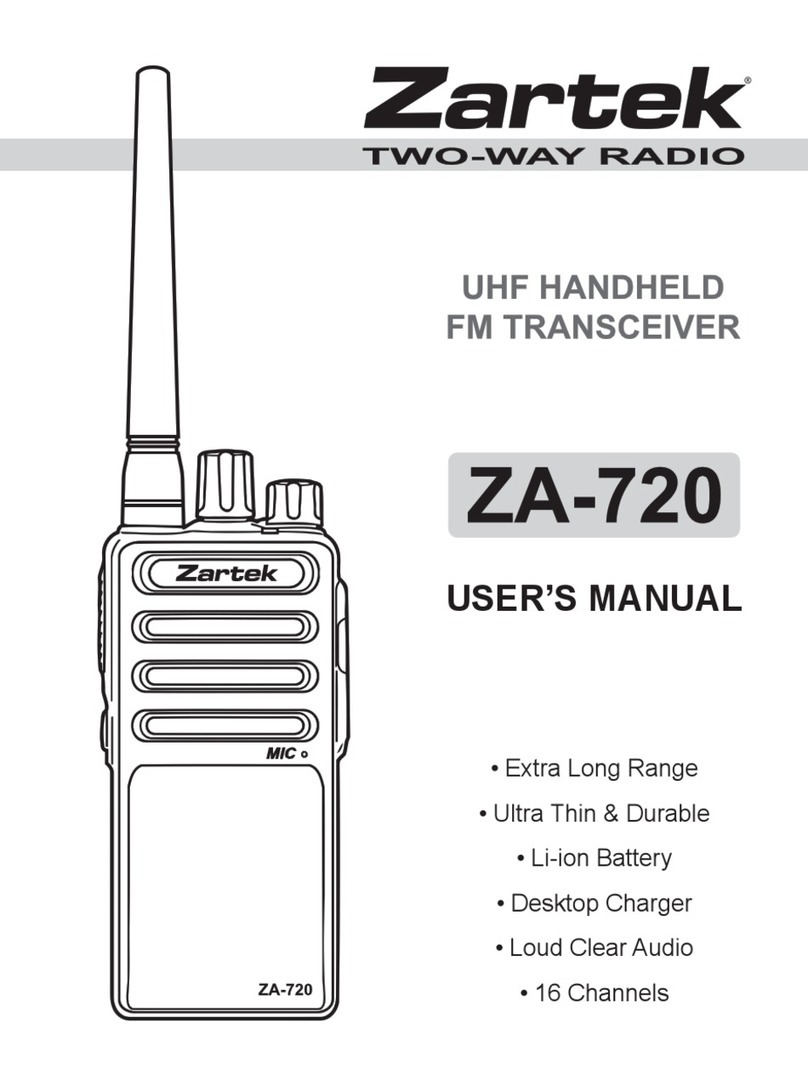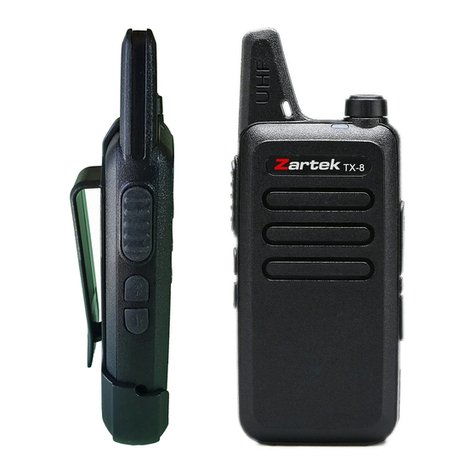ZA-725 User Manual
02
ZA-725 User Manual
01
PROGRAMMING NOTICE!
This transceiver has been factory programmed and
can be used immediately once purchased. All 16
channels have been activated with channels in the
license free bands as per the table. There are 2
bands, PMR 446MHz band with 8 frequencies (1-8)
and the 464MHz band with 5 frequencies (1a-5a).
Select the same channel on any ZA-725 radio to
communicate.
Compatibility:
The ZA-725 is factory programmed to be directly
compatible with all 16 channels on the ZA-758 and
ZA-705 and the first 8 channels on the ZA-708 if they
are set to factory programming. You will need to
reprogram your ZA-725 radio when there is other
programming to be set. If you require
communications with other radios using the 446MHz
band , such as the Zartek Pro8 or COM8, or those
using the 464MHz band, such the Zartek ZA200 or
Pro5, you can change the channels to correspond
with the ZA-725. Both the frequency (1-8 or 1a-5a)
and CTCSS sub tones (1-38) must be the same on all radios. Should there
be interference on a specific channel, select a different channel. Note that
Channel 9, 10 & 11 are set on the open frequency without a sub tone. A sub
tone is used to privatise conversations when using the same frequency.
An optional programming cable is available to program different PMR
446MHz and 464MHz channels and sub tones on the ZA-725. Software is
available for free download from www.zartek.co.za . The programming cable
is connected to the radio to the USB port on a PC. Other settings such as
Scrambler, Squelch level or reassigning the 2 side keys for different functions
can also be programmed. Licence free use of this transceiver limits the
frequencies to the 446MHz and 464MHz bands and the power is restricted to
500mW. If an ICASA license is granted for use of other frequencies (403-470
MHz) and power (4W), special software is available from a registered
SAFETY INFORMATION
Study this manual carefully to understand your transceiver well.
For safety reasons, it is important that the user is aware of and
understands the potential hazards common to using any transceiver.
To clean the radio, wipe with a soft cloth dampened with water. Never use
solvents or cleaners on the radio, they can harm the body and leak inside,
causing permanent damage.
Your radio is not splash proof or waterproof. If the radio gets wet, turn it
OFF and remove battery immediately. Dry the battery compartment to
minimize potential water damage. Leave cover off battery compartment
and do not use until completely dry.
Handle the radio with care and never hold the radio by the antenna. Do
not drop or impact the radio as it contains sensitive electronics.
Do not operate the transceiver or replace/charge the battery in an
explosive environment (dust, gas, fumes etc).
Switch the transceiver off whilst filling gas or when parked at a petrol
station.
Do not open or modify the transceiver in any way.
Refer to a qualified technician for any service or repairs.
Do not expose the transceiver to long periods of direct sunlight, extreme
hot environments or surfaces.
Do not place the transceiver in excessively dusty, humid, wet and/or
unstable areas.
Please turn off the radio when you are close to a blast area or detonator
zone.
Do not use any radio which has a damaged antenna. It may cause a minor
burn when the damaged antenna touches your skin.
To avoid the problems caused by EMI and EMC, turn off your radio where
notices “Please turn off your radios” are posted, such as hospitals.
Turn off your radio before boarding an aircraft. Any use of the radio must
be in accordance with airline regulations or flight crew’s instructions.
If a vehicle is fitted with an air bag, do not place the antenna of the radio
within the air bag expand area.
When the portable radio is transmitting, hold the radio in a vertical position
and speak into the Microphone.
If you carry a radio on your body, please keep the antenna away from
your body by at least 2.5cm when transmitting.
CH Freq Tone
number number
1
2
3
4
5
6
7
8
9
10
11
12
13
14
15
16
1
2
3
4
5
6
7
8
1
2
3
1a
2a
3a
4a
5a
10
10
10
10
10
10
10
10
OFF
OFF
OFF
15
15
15
15
15
Table of programmed
channels





























